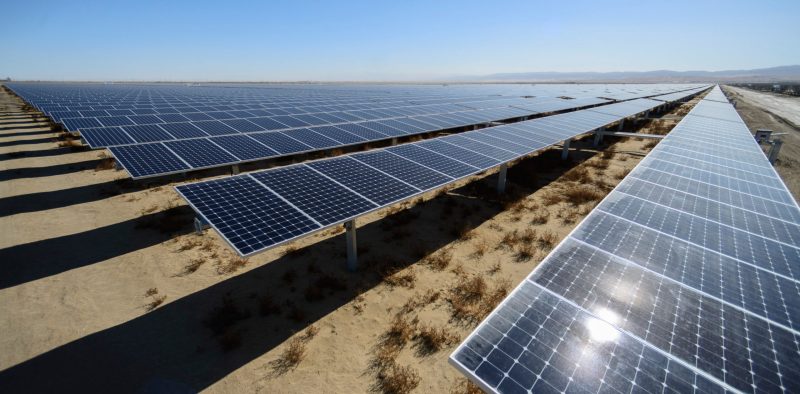The University announced in March 2022 that it was transitioning to be “100% renewable,” but what does that actually mean?
With the purchase of a second solar generating station in 2022 near Lemoore, Calif. in the Central Valley, Stanford now boasts “100% renewable” electricity. Stanford previously purchased a solar generating station in Rosamond, Calif. in 2016.
This does not mean that the electricity used to power Stanford campus comes directly from these solar plants but rather that Stanford’s solar generating stations generate an equivalent or greater amount of energy than the University’s annual energy consumption.
“With the exception of rooftop solar, Stanford’s solar generating stations do not directly feed campus electricity demand,” wrote University spokesperson Luisa Rapport in a statement to The Daily. “Stanford’s electrical demand does not line up minute-by-minute or even hour-by-hour with the solar electricity that Stanford generates,” Rapport wrote.
The electricity powering the lights in the dining halls, the washing machines in the dorms and all other electricity demands on campus is supplied by PG&E, which claims 48% of its energy is renewable and 9% is from natural gas. The proportion of renewable energy relative to that from fossil fuels like natural gas fluctuates throughout the day, with more natural gas being utilized in the evening when solar energy is not available, according to PG&E.
“All of the electricity we’re getting on campus — if you add it all up on an annual basis, it adds up to ‘X’ megawatts, and [Stanford is] buying an equivalent amount of solar energy,” said Alison Ong, a third-year Ph.D. student in the Emmett Interdisciplinary Program for Environment and Resources (E-IPER).
“The whole grid is interconnected as one. So you don’t get to choose your electrons,” Ong said.
Stanford is purchasing solar offsets to counteract the fossil fuels the school still relies on through PG&E.
The fact that Stanford does not supply its offsets on an hourly basis complicates matters, Ong said. Solar energy is only captured during the day, yet the bulk of energy usage does not fall between sunrise and sunset.
PG&E, which supplies electricity to Stanford and much of Northern and Central California, designates its peak hours of energy demand as 4 to 9 p.m. on weekdays. Especially in the winter months, most of this energy demand cannot be met by solar power, as Stanford currently lacks the energy storage technology to make hourly offsets possible.
According to the US Energy Information Administration, California wasted 5% of solar energy due to curtailment, the practice of reducing solar energy capture when demand will be low in order to avoid stressing the grid. This indicates that the barrier to a completely renewable grid is not a lack of solar energy captured but the ability to deploy that energy when the sun is not out.
Rapport wrote that “[there’s been] significant battery installation at our second solar generating station that allows us to time-shift some of that station’s production under certain circumstances.”
If realized on a larger scale, this development would turn Stanford’s fossil fuel offsets to a minute-by-minute model, an important step towards an entirely renewable grid. With these improvements to energy storage, Ong said that Stanford is “stepping in the right direction,” although she still sees one major challenge: logistics.
“It matters where you site something like storage or a power plant because if you put it in Southern California, with your big centers of demand or load are, say in the Bay Area … you overload that transmission line,” Ong said. “It’s kind of like driving on a highway or freeway. It gets congested and clogged.”
Jayson Toweh, a second-year Ph.D. student in the E-IPER program said the University needs to take more meaningful measures to move towards renewable energy. “That solar farm would have already existed anyway, whether Stanford had purchased it or not,” Toweh said. “So did we really, basically, offset or really take away dirty energy from the grid?”
Although Stanford offsets its fossil fuel energy use with solar power, Toweh, who is also a member of the Coalition for a True School of Sustainability, pointed out that offsetting is not the same as being carbon neutral. “Going renewable for electricity … doesn’t really show the full picture of what else you’re still [using] fossil fuel-related resources for, whether it funds research, things you’re purchasing, [etc.].” Toweh said.
Toweh said it was important to eliminate fossil fuel funding of research, and address other sustainability issues at Stanford like carbon emissions from travel and a lack of sustainable food options.
“Stanford is not a ‘green’ school,” Toweh said, “I guess it’s moving.”
Rapport wrote that “the University has a target of achieving carbon neutrality, or net zero greenhouse gas emissions, by 2050.”
Ong is cautiously optimistic for Stanford’s carbon-neutral future: “2050 is not tomorrow, but it’s also unnervingly close.”
